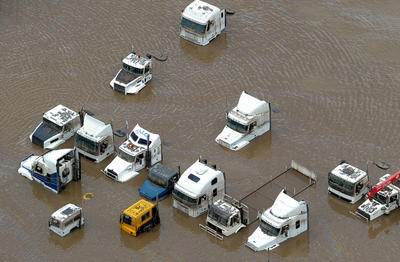In the north, tropical fruit crops such as mangoes and melons have been lost. The sugarcane harvest along the east coast has been disrupted and cane plants have been damaged so that production will be down for up to two years. Vegetable production in key areas such as the Lockyer Valley west of Brisbane has been particularly hard hit.
Inland, the grain crops most severely affected have been wheat and grain sorghum, a stock feed. Not only has the extent of the wheat harvest been reduced but much of the crop has been down-graded from high protein ‘prime hard’ quality to ‘shot and sprung’ stock feed grade.
Meat supplies have also been affected. Not only have beef producers in central Queensland and northwest New South Wales been unable to access their stock because of the slow moving flood waters, but transportation to market has been virtually impossible for several weeks. Roads remain closed due to wash-aways and bridge damage.
These supply effects in the short run will mean higher prices and reduced quality in domestic fruit and vegetable markets. Beef prices in particular will also face upward pressure as will substitute meats such as lamb. Over coming months, as both on- and off-farm infrastructure is repaired, short rotation crops such as vegetables will rebound relatively quickly. Crops of lettuce, beans, cucumbers and the like mature within a couple of months. Similarly, as abattoirs reopen with more truckloads of cattle being able to access saleyards, beef prices will tend to come off. Other seasonal crops such as the grains will need a year (without any further droughts or floods) for supply to be reinstated. Longer turn-around times will be experienced by cane growers and farmers with fruit trees that need replanting.
Export markets likely to be most affected by the 2011 floods are in grains. World prices for wheat and sorghum increased strongly in 2010, approaching the ‘food crisis’ levels reached in 2008. With the world economy emerging from the global financial crisis and growing wealth in Asia causing dietary changes, demand for meat and diary products has picked up. With that up-swing, the demand for stock feeds such as sorghum and wheat as well as soya beans and maize has also risen. This demand surge has been augmented by government policies that have supported ethanol production as a fossil fuel substitute. With Australian wheat and sorghum exports significantly reduced, supply will be less able to match these demand hikes, and the upward pressures on grain prices observed in late 2010 are likely to be enhanced in 2011.
The floods in Central Queensland have also reduced Australia’s coal export earnings. Flooded open cut mines have been taken out of production and transport infrastructure damage is likely to further delay the resumption of deliveries. This, together with reduced agricultural export earnings, will increase Australia’s balance of trade deficit and potentially put some downward pressure on the value of the Australian dollar.
The immediate price shocks resulting from domestic shortages of fruit, vegetables and meat will be inflationary in the short term. Furthermore, the added demand in the economy caused by the recovery effort — especially in the skilled trades end of the labour market — will have longer term inflationary impacts, especially as the resources boom is rekindled after the global financial crisis.
Australian farmers are a resilient lot. They are well-accustomed to responding to the variability of the Australian climate. Hence there is good reason to suggest that agricultural supply recovery will be relatively swift within nature’s bounds. There is even some cause for optimism. The build up of sub-surface soil moisture over this summer suggests that the 2011 wheat crop will at least have a good start. Similarly, full dams will give confidence to growers of next summer’s irrigated crops such as cotton and grain sorghum. Wool growers in the western districts of Queensland and New South Wales will also take advantage of good pasture growth, especially on the flood plains that have been well watered by multiple flood events.
This optimism must be tempered by the realisation of Australia’s harsh climate variability. It is a feature of Australian life that is celebrated in national culture. Dorothea McKellar’s iconic poem ‘My Country’, written in 1908, referred to Australia as ‘a land of droughts and flooding rain’ and a ‘wilful lavish land’. And in 1921 another Australian poet, John O’Brien, created Hanrahan, the Australian farmer who ruefully bewailed that ‘we’ll all be roooned …’ unless it rained or indeed stopped raining (depending on the season) ‘… before the year is out’.
Jeff Bennett is Professor and Director of the Environmental Economics Research Hub in the Crawford School of Economics and Government at the Australian National University.

